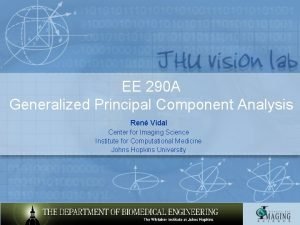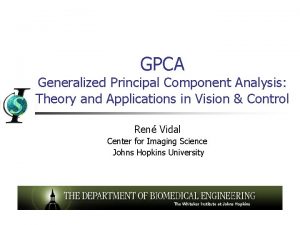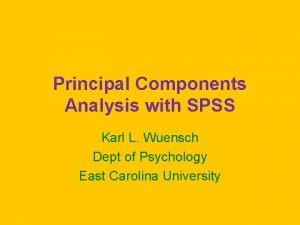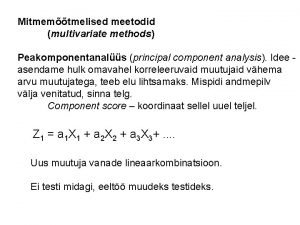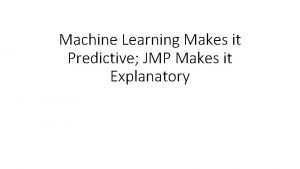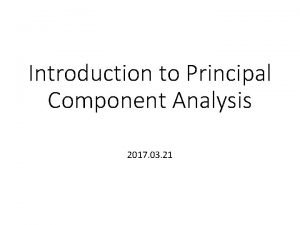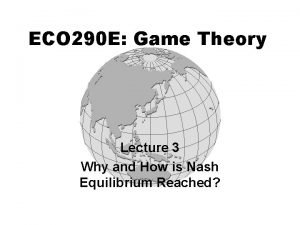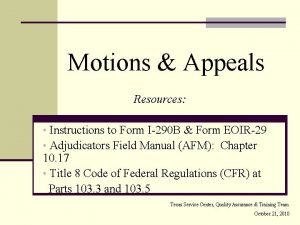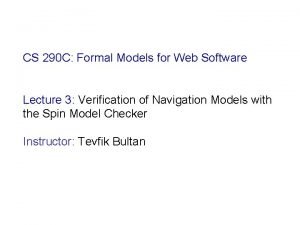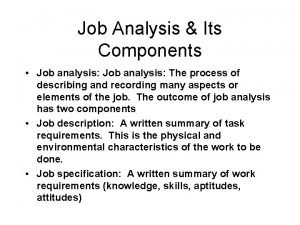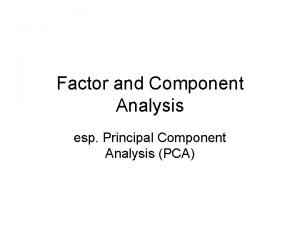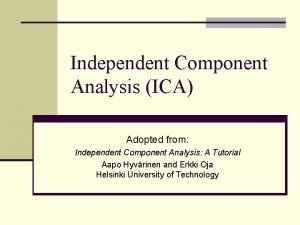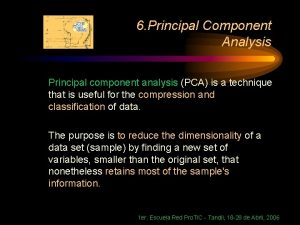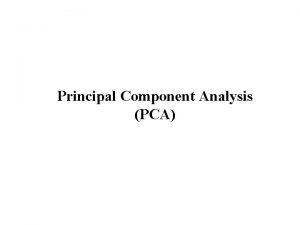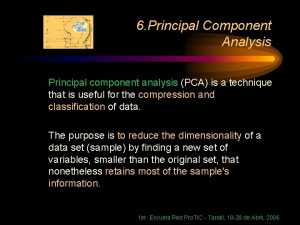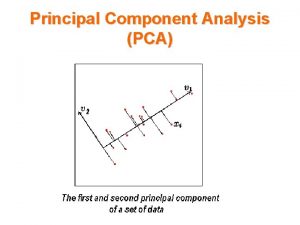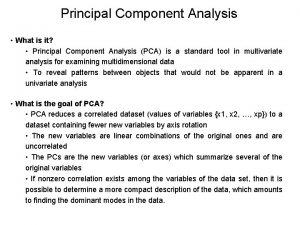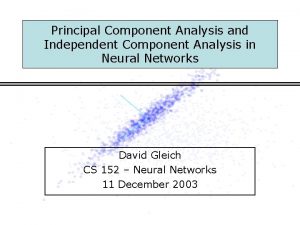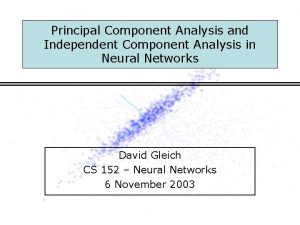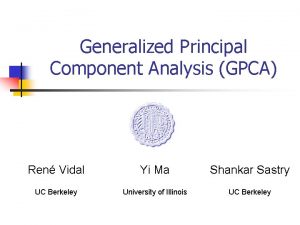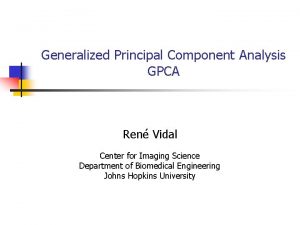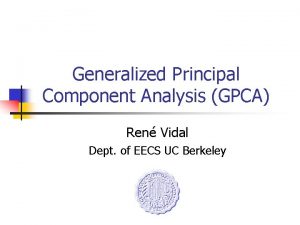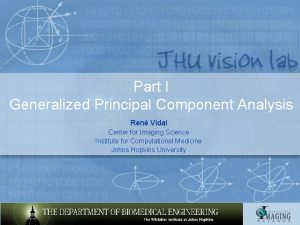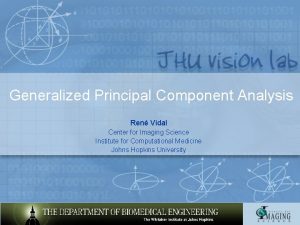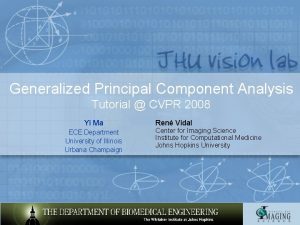EE 290 A Generalized Principal Component Analysis Lecture






















- Slides: 22

EE 290 A: Generalized Principal Component Analysis Lecture 2 (by Allen Y. Yang): Extensions of PCA Sastry & Yang © Spring, 2011 EE 290 A, University of California, Berkeley 1

Last time n n Challenges in modern data clustering problems. PCA reduces dimensionality of the data while retaining as much data variation as possible. Statistical view: The first d PCs are given by the d leading eigenvectors of the covariance. Geometric view: Fitting a d-dim subspace model via SVD Sastry & Yang © Spring, 2011 EE 290 A, University of California, Berkeley 2

This lecture n n Determine an optimal number of PCs: d Probabilistic PCA Kernel PCA Robust PCA shall be discussed later Sastry & Yang © Spring, 2011 EE 290 A, University of California, Berkeley 3

Determine the number of PCs n Choosing the optimal number of PCs in noise -free case is straightforward: Sastry & Yang © Spring, 2011 EE 290 A, University of California, Berkeley 4

n In the noisy case knee point Sastry & Yang © Spring, 2011 EE 290 A, University of California, Berkeley 5

A Model Selection Problem n n With moderate Gaussian noise, to keep 100% fidelity of the data, all D-dim must be preserved. However, we can still find tradeoff between model complexity and data fidelity? Sastry & Yang © Spring, 2011 EE 290 A, University of California, Berkeley 6

More principled conditions Sastry & Yang © Spring, 2011 EE 290 A, University of California, Berkeley 7

Probabilistic PCA: A generative approach Sastry & Yang © Spring, 2011 EE 290 A, University of California, Berkeley 8

n n n Given sample statistics, (*) contains ambiguities Assume y is standard normal, and εis isotropic Then each observation is also Gaussian Sastry & Yang © Spring, 2011 EE 290 A, University of California, Berkeley 9

Determining principal axes by MLE n Compute the log-likelihood for n samples n The gradient of L leads to stationary points Sastry & Yang © Spring, 2011 EE 290 A, University of California, Berkeley 10

n Two nontrivial solutions Sastry & Yang © Spring, 2011 EE 290 A, University of California, Berkeley 11

Sastry & Yang © Spring, 2011 EE 290 A, University of California, Berkeley 12

Kernel PCA: for nonlinear data n Nonlinear embedding Sastry & Yang © Spring, 2011 EE 290 A, University of California, Berkeley 13

Example Sastry & Yang © Spring, 2011 EE 290 A, University of California, Berkeley 14

Question: How to recover the coef? n Compute the null space of the data matrix n The special polynomial embedding is called the Veronese map Sastry & Yang © Spring, 2011 EE 290 A, University of California, Berkeley 15

Dimensionality Issue in Embedding n Given D and order n, what is the dimension of the Veronese map? n Often the dimension blows up with large D or n. Question: Can we find the higher-order nonlinear structures without explicitly calling the embedding function? Sastry & Yang © Spring, 2011 EE 290 A, University of California, Berkeley 16

Nonlinear PCA n Nonlinear PCs Sastry & Yang © Spring, 2011 EE 290 A, University of California, Berkeley 17

n In the case M is much larger than n Sastry & Yang © Spring, 2011 EE 290 A, University of California, Berkeley 18

Kernel PCA n n n Computations in NLPCA only involve inner products of the embedded samples, not the samples themselves. Therefore, the mapping relation can be expressed in the computation of PCA without explicitly calling the embedding function. The inner product of two embedded samples is called the kernel function. Sastry & Yang © Spring, 2011 EE 290 A, University of California, Berkeley 19

Kernel Function Sastry & Yang © Spring, 2011 EE 290 A, University of California, Berkeley 20

Computing NLPCs via Kernel Matrix Sastry & Yang © Spring, 2011 EE 290 A, University of California, Berkeley 21

Examples of Popular Kernels n Polynomial kernel: n Gaussian kernel (Radial Basis Function): n Intersection kernel: Sastry & Yang © Spring, 2011 EE 290 A, University of California, Berkeley 22
 Generalized principal component analysis
Generalized principal component analysis Generalized principal component analysis
Generalized principal component analysis Spss principal component analysis
Spss principal component analysis Principal component analysis
Principal component analysis Principal component analysis jmp
Principal component analysis jmp Principal component analysis
Principal component analysis Tceq 290
Tceq 290 A 290. számú auschwitzi fogoly
A 290. számú auschwitzi fogoly Eco 290
Eco 290 I 290 b
I 290 b Specs 290 and jones
Specs 290 and jones Cs 290
Cs 290 Myuiemployer
Myuiemployer 01:640:244 lecture notes - lecture 15: plat, idah, farad
01:640:244 lecture notes - lecture 15: plat, idah, farad Component of job analysis
Component of job analysis Independent component analysis vs pca
Independent component analysis vs pca Independent component analysis tutorial
Independent component analysis tutorial Exploratory data analysis lecture notes
Exploratory data analysis lecture notes Sensitivity analysis lecture notes
Sensitivity analysis lecture notes Factor analysis lecture notes
Factor analysis lecture notes Analysis of algorithms lecture notes
Analysis of algorithms lecture notes Streak plate method
Streak plate method Zline 667-36
Zline 667-36
